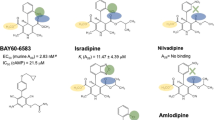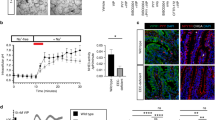Abstract
THE molecular mechanism by which cholera toxin produces a massive loss of water and electrolytes is unknown, but it is clear that an increase in net secretion of approximately isotonic fluid occurs throughout the length of the small intestine1,2. The relative contributions of increased active ion secretion and decreased active ion reabsorption to this fluid production are also unknown, although the fluid contains more HCO−3 than does plasma1,3. The toxin might stimulate secretory transport processes, for example Cl− and HCO−3, to such an extent that reabsorptive capacity is exceeded, water is held osmotically and massive diarrhoea results.
This is a preview of subscription content, access via your institution
Access options
Subscribe to this journal
Receive 51 print issues and online access
$199.00 per year
only $3.90 per issue
Buy this article
- Purchase on SpringerLink
- Instant access to full article PDF
Prices may be subject to local taxes which are calculated during checkout
Similar content being viewed by others
References
Banwell, J. G., Pierce, N. F., Mitra, R. C., Caranosos, G. J., Keimowitz, R. I., Mondal, A., and Manji, P. M., Indian J. Med. Res., 56, 1 (1968).
Carpenter, C. C. J., and Greenough, W. G., J. Clin. Invest., 47, 2600 (1968).
Carpenter, C. C. J., Sack, R. B., Feeley, J. C., and Steenberg, R. W., J. Clin. Invest., 47, 1210 (1968).
Greenough, W. B., Al-Awqati, Q., and Carpenter, C. C. J., J. Clin. Invest., 48, 32a (1969).
Field, M., Plotkin, G. R., and Silen, W., Nature, 217, 469 (1968).
Lowry, O. H., Rosenbrough, N. J., Farr, A. L., and Randall, R. J., J. Biol. Chem., 193, 265 (1951).
Brooker, G., Thomas, L. J., and Appleman, M. M., Biochemistry, 7, 4177 (1968).
Brooker, G., and Appleman, M. M., Biochemistry, 7, 4182 (1968).
Krishna, G., Weiss, B., and Brodie, B. B., J. Pharmacol. Exp. Ther., 163, 379 (1968).
Cohnheim, S. F., Lectures of General Pathology: A Handbook for Practitioners and Students (translated from second German edition of A. D. McKee), 3, (New Sydenham Society, London, 1889–90).
Goodpasture, E. W., Philippine J. Sci., 22, 413 (1923).
Gangarosa, F. T., Beisel, W. R., Benyajati, C., Sprinz, H., and Piyaratn, P., Amer. J. Trop. Med. Hyg., 9, 125 (1960).
Weaver, R. T., Johnson, M. K., and Phillips, R. A., J. Egypt Publ. Health Assocn., 23, 5 (1948).
Gordon, jun., R. S., Proc. SEATO Conf. Cholera, 54 (Post Publishing Co. Bangkok, 1962).
Love, A. M. G., Gut, 10, 63 (1969).
Greenough, W. B., Pierce, N. F., and Vaughan, M., J. Infect. Dis., 121, S111 (1970).
Finkelstein, R. A., J. Infect. Dis., 121, Suppl. S63–S72 (1970).
Greenough, W. B., and Carpenter, C. C. J., Texas Rep. Biol. Med., 27, 203 (1969).
Craig, J. P., Nature, 207, 614 (1965).
Vaughan, M., Pierce, N. F., and Greenough, W. B., Nature, 226, 658 (1970).
Snow, J., On the Mode of Communication of Cholera, second ed. (Churchill, London, 1855).
Author information
Authors and Affiliations
Rights and permissions
About this article
Cite this article
SHARP, G., HYNIE, S. Stimulation of Intestinal Adenyl Cyclase by Cholera Toxin. Nature 229, 266–269 (1971). https://doi.org/10.1038/229266a0
Received:
Revised:
Issue Date:
DOI: https://doi.org/10.1038/229266a0



